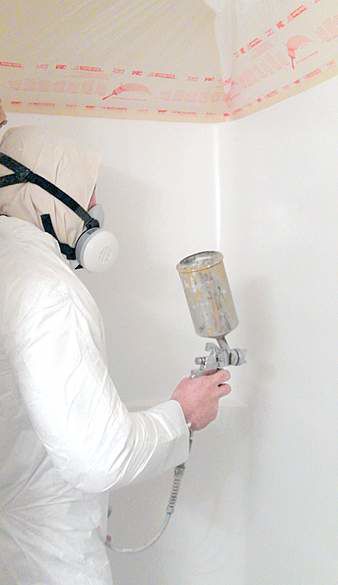Fiberglass requires care
Published 5:00 am Tuesday, April 26, 2011

- Chris Hess sprays a new coating on the fiberglass. Refinishing a fiberglass stall is a complex process generally requiring a couple of days, specialized tools and professional know-how. The cost will be about $450.
That fiberglass shower stall (or bathtub or sink) is becoming embarrassing.
The bathroom gets regular cleaning, but no matter what you do, it seems, the soap scum and grime build up on the fiberglass. The dingy, grubby look on that fixture drags down the appearance of the rest of the bathroom. And what happens if you try to sell your house? Is the dirty-looking fiberglass going to end up as one of the items the sale closing hinges upon?
You may decide the shower needs replacing. But that creates another problem: Where would you find another small, narrow tub or shower to fit that space?
Those problems may be averted with some regular cleaning, using the correct cleansers, tools and techniques, says Steve Hess, owner of ABC Painting in Bend.
Water drops cling to shower walls and dry, leaving a ledge of mineral deposits. After every shower, additional drops will cling to the mineral deposit. The mineral ledge grows larger, attracting more drops, minerals and soap scum.
Some experts recommend wiping down the shower with a squeegee or chamois after every use.
Others claim that using a daily shower mist product after each shower does a good job and saves extra work when it comes to the recommended weekly shower cleaning.
But who has time for that in the morning, when you’re rushing to get the kids to school and trying to get to work on time?
Hess cleans his shower weekly, he said, and follows a routine designed to maintain the appearance of the fiberglass. Hess always wears a respirator while cleaning, he said, because the fumes of some cleaners could be toxic.
“Start with a nonabrasive cleaner on fiberglass, such as Soft Scrub or Comet Scratch Free,” Hess advises. “Don’t use the abrasive cleaners that are designed for porcelain or glass.”
Abrasives tend to scratch and roughen up the gel coat on fiberglass, he added, making the surfaces more attractive to mineral deposits and scum.
Then, use a soft scrubbing tool.
“Those soft, two-sided sponge scrubby things, like you use for washing dishes, will work well without scratching the finish,” Hess said, referencing the no-scratch scrubbers he likes (not the abrasive, green scrubber). “If you use an abrasive material, such as steel wool, you’ll take the finish off along with the dirt and soap scum.”
There are many cleaning products available that are good scum and mineral deposit removers if given the time to dissolve, Hess said, but most people probably don’t give their cleaning products time to work.
“Spray the surface with the cleanser, then let it sit,” Hess advises. “Then, after a few minutes, hit it again with the cleanser, and scrub the surface with the scrubby.”
Repeat applications may be necessary for severe buildups. Spraying and immediately wiping tends to be ineffective where there are scum and minerals. Also, Hess said, fiberglass has about a 10-year lifespan before it starts to lose that “new” look.
In some cases, severe soap scum buildup, scratched surfaces and age require that the fiberglass be refinished. While there are kits available for do-it-yourselfers, Hess recommends the job be left to experts.
“We tried several of the kits, and they just don’t work that well,” he said. “We’re professional painters, and we still ended up with brush marks, and the end result didn’t look that good.”
A professional refinishing job of a fiberglass fixture is a complex process, Hess said. The complete job will take between one and two days, he said, and require some expensive professional tools.
The process starts by removing all the doors, frames, faucets and drain. The surface is scrubbed clean, then sanded to remove all the stains and rough up the fiberglass so it will hold the finish. Then it is degreased before the initial primer coat is applied.
“We mask off the whole room, then use an air pump system to remove the fumes and dust and vent them outside,” Hess said. “A two-part epoxy is applied to bind the finish to the surface.”
After that, two or three coats of epoxy are applied and allowed to dry, and the surface is sanded again before two or three more coats of light epoxy are sprayed on. When completed, Hess said, the fiberglass will look new again.
The cost of refinishing a shower stall, Hess said, will be about $450. A replacement, he said, would cost about the same amount, but that doesn’t include the plumbing and drywall work, painting and installation. A complete replacement shower stall, he estimates, would end up costing between $1,800 and $2,500.
“The whole process is very messy, and you’ll get dust all over. You need to wear a respirator,” Hess said. “All of these chemicals are toxic, and they are very bad to breathe or come in contact with. In the long run, you’re best off letting a pro do the job.”
Or, maintain your fiberglass correctly from the beginning, starting with no-scratch cleaning practices.






